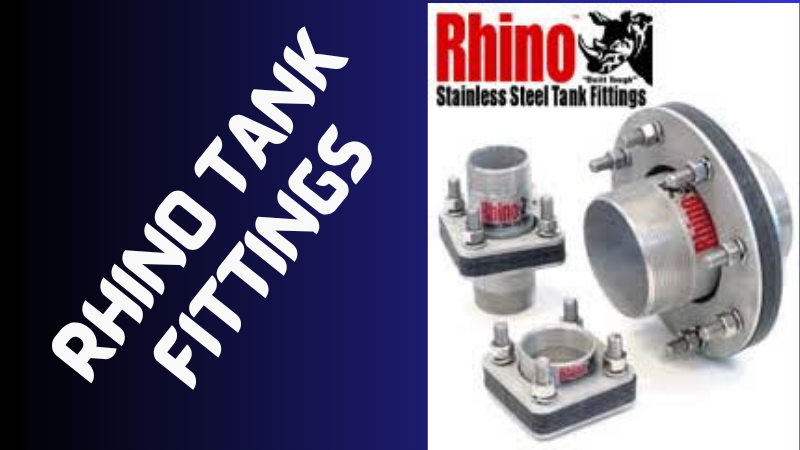Rhino Tank Fittings are known for their robust construction, leak-proof performance, and compatibility with a wide range of storage solutions. Whether you’re setting up a rainwater harvesting system, a commercial water storage facility, or an agricultural irrigation system, the right fittings will ensure that your tank operates at peak performance for years to come.
What Are Rhino Tank Fittings?
Rhino tank fittings are specialized connectors, valves, and accessories designed to manage the flow of liquids into and out of Rhino water tanks. These fittings can include inlets, outlets, overflows, and valves—all engineered to withstand high water pressures, varying weather conditions, and constant use.
Importance of Choosing the Right Fittings
Using the wrong fittings can lead to leaks, contamination, or reduced water flow. Rhino tank fittings are specifically designed to match the dimensions, materials, and flow requirements of Rhino tanks, ensuring a perfect fit and reliable performance.
Types of Rhino Tank Fittings
Inlet Fittings
These fittings control the entry of water into the tank. They’re often paired with strainers or filters to prevent debris from entering and contaminating stored water.
Outlet Fittings
Located at the base or lower side of the tank, outlet fittings allow water to be drawn out for use in irrigation, plumbing, or industrial processes.
Overflow Fittings
Overflow fittings prevent excess water from spilling over the tank’s top by redirecting it safely away from the structure, reducing erosion and flooding risks.
Valve Fittings
Valves help regulate the water flow and can completely shut off supply when necessary. Rhino valves are precision-engineered for easy operation and minimal leakage.
Specialty & Custom Fittings
These include fittings tailored for chemical storage, fire suppression systems, or specialized industrial uses.
Materials Used in Rhino Tank Fittings
Polyethylene Fittings
These lightweight, corrosion-resistant fittings are perfect for potable water and are UV-stabilized for outdoor use.
Brass and Stainless Steel Options
For high-pressure or heavy-duty applications, brass and stainless steel fittings offer superior strength and resistance to wear.
Pros and Cons of Each Material
Polyethylene is affordable and chemical-resistant but not ideal for extremely high pressures. Brass and stainless steel are durable but cost more and may require periodic maintenance.
How to Choose the Right Rhino Tank Fitting
Capacity and Tank Size Considerations
The fitting size must match the tank’s capacity to ensure efficient flow rates.
Environmental and Weather Conditions
UV exposure, freezing temperatures, and chemical contact should influence your material choice.
Compatibility with Tank Type
Always match fittings to your specific Rhino tank model for best performance.
Installation Process for Rhino Tank Fittings
Tools and Equipment Required
Common tools include spanners, hole saws, sealant tape, and wrenches.
Step-by-Step Installation Guide
-
Mark the fitting position.
-
Drill the hole according to the fitting size.
-
Clean the edges to prevent leaks.
-
Insert the fitting and tighten securely.
-
Test for leaks before use.
Common Installation Mistakes to Avoid
-
Over-tightening, which can crack the tank wall.
-
Using incompatible sealants.
-
Ignoring manufacturer’s torque specifications.
Maintenance and Care Tips
Routine Inspection Checklist
-
Check for cracks.
-
Ensure seals are intact.
-
Inspect valves for smooth operation.
Cleaning and Preventing Blockages
Flush fittings regularly to prevent sediment buildup.
Replacing Damaged Fittings
Prompt replacement prevents larger system failures.
Troubleshooting Common Problems
Leaks and Seal Failures
Often caused by worn gaskets or loose fittings—replace seals as needed.
Reduced Water Flow Issues
Blockages in pipes or filters are common culprits.
Cracks and Material Wear
Usually due to prolonged exposure to sunlight or chemicals.
Cost of Rhino Tank Fittings
Price Ranges by Type
Poly fittings: $10–$30
Brass fittings: $30–$80
Stainless steel: $50–$120
Factors Affecting Cost
-
Material type
-
Size
-
Special features like anti-vortex design
Where to Buy Genuine Rhino Tank Fittings
Authorized Dealers and Online Stores
Purchasing from official Rhino resellers ensures warranty protection.
Avoiding Counterfeit Products
Look for the Rhino logo and official packaging.
Benefits of Using Rhino Tank Fittings
Durability and Longevity
Made to withstand harsh Australian conditions.
High Flow Efficiency
Optimized internal diameters for maximum water delivery.
Low Maintenance Requirements
Minimal upkeep compared to generic fittings.
Comparing Rhino Tank Fittings with Other Brands
Performance and Quality
Rhino fittings consistently outperform in leak tests.
Cost and Value for Money
Higher upfront cost but longer service life reduces total ownership cost.
Safety Standards and Compliance
Food-Grade and Potable Water Safety
Certified safe for drinking water storage.
Industry Certifications
Compliant with Australian and international water storage standards.
Frequently Asked Questions about Rhino Tank Fittings
-
Can Rhino tank fittings be used on non-Rhino tanks?
Yes, but compatibility should be confirmed with measurements. -
How often should fittings be replaced?
Every 5–10 years, depending on material and use. -
Do they come with a warranty?
Yes, most genuine Rhino fittings come with a manufacturer’s warranty. -
Are Rhino fittings safe for hot water?
Metal fittings can handle higher temperatures, but plastic ones are designed for cold or ambient water. -
Can I install them myself?
Yes, if you follow the manufacturer’s instructions carefully. -
Where can I find replacement parts?
Through official Rhino distributors or their online store.
Conclusion
Rhino Tank Fittings are a worthwhile investment for anyone serious about water storage efficiency and reliability. With the right selection, proper installation, and regular maintenance, these fittings can serve you for years without issues. They not only improve your tank’s performance but also ensure your water remains safe and clean.

